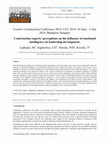Papers by titus ebenezer Kwofie

International Journal of Construction Management
As technology is becoming advanced, the way of visualizing simulations and information has got be... more As technology is becoming advanced, the way of visualizing simulations and information has got better which makes the real and virtual world look alike. This study evaluates the critical success factors that affect the implementation of augmented reality in the construction industry. A well-structured questionnaire was sent to survey construction professionals engaged in the built environment in the study area. The professionals engaged are project managers, architects, quantity surveyors, engineers, and builders. Convenience sampling techniques was adopted in choosing those professionals. Percentile, Frequency, Standard Deviation (SD), Mean item score (MIS) and One Sample t-test were adopted in analyzing the collected data. The result revealed there is full awareness of ICT for respondents while approximately 50% have used mobile AR computing. The five most critical success factors for Augmented Realities are the need for innovativeness in executing construction projects, advancement in computer design interface and hardware device, improvement of accuracy in AR technology, development in mobile computing, and AR collaboration with ICT software. It was revealed that there is significant importance attached by professionals to all the critical success factor (CSF) for augmented realities. The study concluded for augmented reality to gain ground in the construction industry it is important stakeholders are ready to accept innovation in the use of new trends of technology. It is therefore recommended there should be government policies that support, enforces, and implement the use of new trends of technology in construction projects for efficiency and productivity.

The Construction Industry in the Fourth Industrial Revolution, 2019
Building regulation is considered as a remarkable means for ensuring orderly and sustainable deve... more Building regulation is considered as a remarkable means for ensuring orderly and sustainable development. Unfortunately, it has become a fault line and an elusive tool for developing countries. In Ghana, the chronic collapse of buildings, haphazard developments and increased number of defective buildings are signs of weaknesses in the enforcement of building controls. Based on the perspective of architects, the study seeks to confirm the key factors that accounts for the laxity in enforcement process and the potential use of smart building regulations to improve the system. Architects present during the Annual General Meeting of architects in Ghana were purposively sampled to answer survey questionnaires. Based on response from 86 architects, institutional factors; Inefficient and Insufficient Staff, Corruption and Absence of Public-Private Partnership were established as key factors that impacts negatively on enforcement of building regulations. The study recommends the use of smart approaches for effective building controls in Ghana.

Environment, Development and Sustainability, 2017
Threats of climate change and future energy price uncertainty have led to a global debate on ener... more Threats of climate change and future energy price uncertainty have led to a global debate on energy efficiency, particularly the energy efficiency of housing projects. This serious global problem calls for improvement in energy efficiency from all sectors, especially the building sector which is considered a major energy consumer. Adoption of energy efficiency design practices in the housing sector has been perceived to have a significant potential to contribute greatly to the sustainable building process. Additionally, most studies indicate that the understanding and integration of stakeholder requirements has an enormous potential towards increasing the sustainability perspectives that relate to social, environmental, economic and technical issues of buildings. However, there is enough evidence from several studies suggesting a lack of common perspective on stakeholder requirements towards building energy efficiency (BEE) in housing development. Hence it is argued that stakeholders' alignment for energy efficiency improvement is crucial and a fundamental challenge that needs to be addressed if the goal of energy use reduction in buildings is to be achieved. The aim of this paper is to identify the important building energy requirements among stakeholders of mass housing projects and their impact on technical characteristics of mass housing projects. Through a survey of building industry stakeholders and using the House of Quality model for analysis of the data obtained, the study identified five (5) most rated BEE stakeholders' requirements in respect of housing development. The study gives a new insight into the considerations of building stakeholders regarding energy efficiency. This insight is useful towards achieving Electronic supplementary material The online version of this article (

Purpose The South African Construction Industry (SACI) in recent times has been characterized by ... more Purpose The South African Construction Industry (SACI) in recent times has been characterized by a strong emphasis towards achieving sustainable building practices in infrastructural delivery. However, the lack of progress encountered in making gains in achieving sustainable practices has raised concerns over the effectiveness and understanding of the extent to which life cycle assessment (LCA) techniques may aid in meeting requirements of sustainable construction. Most efforts at LCA have been blighted with numerous barriers that have not been rigorously pursued and aggregated. Ironically, there is a lack of knowledge and understanding of the limitations and barriers to these methodologies, especially in the South African context. The purpose of this study is to delineate the cluster of barriers to the adoption of LCA methodologies in the SACI. Design/methodology/approach A questionnaire survey was carried out from a deductive research design elicit primary data based on the experi...

Even though communication skills is argued as very essential to project team effectiveness, emerg... more Even though communication skills is argued as very essential to project team effectiveness, emerging globalization, increased virtuality, interdependence, collaborative and multi-disciplinary nature of project teams underscores for urging need for new strategies and desired communication behaviours that are crucial for organizing projects efficiently towards managerial effectiveness. However, matching communication behaviours of construction project teams to unique project typologies remains a grey area. The aim of this study was to identify the behavioural communication competencies that are very crucial to effective communication performance among mass housing project team. The study adopted a two stage methodological approach involving extensive exploratory review of related literature and qualitative interview. Through an exploratory qualitative enquiry, Task functional communication competencies and Psycho-social communication competencies were identified as essential communica...

International Journal of Construction Supply Chain Management
Recent researchinto construction supply chain, has identified need to pursue the drivers for effe... more Recent researchinto construction supply chain, has identified need to pursue the drivers for effective collaborative working in construction project delivery. Identification and implementation of the drivers for effective collaboration is deemed to be the precursor for optimising the benefits of collaborative working in construction project delivery. However, there has been little research that focus on key drivers of collaborative working in the construction sector compared to the manufacturing, production and service delivery sectors. The aim of this study is to identify the key drivers for effective collaborative working in construction project delivery. The study primarily adopted an exploratory qualitative design using interviews on three case study projectsthatadopted collaborative working in South Africa. The data was analysed using thematic analysis. The results revealed, efficient operational governance practices in team work, effective Integration strategies in team manage...

Benchmarking: An International Journal
PurposeThe perception that the repetitive nature and attributes of mass housing projects (MHPs) i... more PurposeThe perception that the repetitive nature and attributes of mass housing projects (MHPs) induce significant influence on communication among projects teams have persistently been acknowledged without an empirical accentuation. This seemingly untested knowledge tends to limit the predictive accuracy of success and effectiveness of adopted communication style, strategies and models in mass housing particularly due to the incidence of the repetitive attributes. The purpose of this study is to delineate the influence of the repetitive attributes of mass housing projects on communication performance among the project team.Design/methodology/approachThrough the use of questionnaire survey and structural equation modelling analysis, a hypothesized model tested evaluated the effects of the repetitive attributes of mass housing on information flow and information composition communication performance.FindingsIn the case of influence on information flow, it was seen to be substantial w...
International Journal of Construction Management

Effective Construction Project Delivery
In today’s digitalization era, the global construction industry has witnessed a naissance Informa... more In today’s digitalization era, the global construction industry has witnessed a naissance Information Communication Technology (ICT) tools and platforms for which have had significant impact on the way project teams and organizations interact as well as having impact on storing, processing, retrieving, disseminating and sharing of information. The information-intensive nature of construction project delivery process requires real-time access and flow of information between all the project team members. Given the present scenario, when project participants are geographically separated and with increased virtuality, adoption of ICT that enables effective communication is critical. However, despite the wave of enthusiasm for many ICT tools such as intranet, Internet, extranet, project Website, BIM, Internet of things, augmented and virtual reality as a platform for information sharing and interactions, among project teams, issues of their performance and information-sharing behaviours across various procurement typologies are yet to be explored as a strategic tool towards effective communication. In the current state of the industry, there is also growing recognition of the need to understand the ICT needs of the individuals and how they use these tools to communicate within project teams to engender effective communication. Additionally, project team participants come from different organizations and perform varied roles using varieties of information systems and tools, having different rates of adoption of the available communication tools as well as preferences for specific means of communication and information sharing. In the current digitalization era, the effectiveness of the project team information sharing and interactions is dependent on clear understanding of the performance of specific ICT communication media and tools adopted across various procurement typologies and their information-sharing behaviours. This chapter explores the evolution of ICT tools and platforms for information sharing and interaction in construction project delivery in non-traditional procurement models. This knowledge will enable the strategic adoption of ICT tools for information sharing and interactions among project teams in construction project delivery. By this strategic drive, the use of these ICT tools can aid in improving collaborative working and integration of project participants which is proving to be elusive in practice especially in conventional procurement models.
Journal of Construction in Developing Countries
Amissah (2020). Ontology of the communication performance prospects of Building Information Model... more Amissah (2020). Ontology of the communication performance prospects of Building Information Modelling adoption among project teams in construction project delivery.

International Journal of Services and Operations Management
Plethora of research have indicated that task performance is influenced by the level of project t... more Plethora of research have indicated that task performance is influenced by the level of project team effectiveness and team control. However, little is known about the influence of team control on construction project team effectiveness. Using a questionnaire survey and a partial least square structural equation modelling (PLS-SEM) analysis, this study explored the effects of dynamics of team control on the level of team effectiveness in construction project delivery. The results revealed that formal control (FC) and informal control (IC) account for about 65% (0.648) and 30% (0.304) respectively of the total 71.0% variance in the level of team effectiveness in project delivery. Thus, formal and informal controls in project teams make substantial and moderate effects respectively to the level of team effectiveness in project delivery. Thus, project teams can enhance and legitimise their formal and informal controls in project delivery towards improving their effectiveness in task and team performance.

Proceedings of the Creative Construction Conference 2019, 2019
Notwithstanding the significance of leadership within organisations and social settings, there se... more Notwithstanding the significance of leadership within organisations and social settings, there seems to be less information about the influence of emotional intelligence on leadership development in the construction industry. The purpose of the research was to establish the influence of emotional intelligence on leadership and leadership development in the construction industry. The ongoing leadership challenge in the construction industry seeks research to determine the importance of emotional intelligence in leading teams. The research launched with an extensive review of literature in order to identify the core and sub-variables which embodies emotional intelligence and leadership for leadership development. A three iterative round Delphi technique was conducted to attain consensus of the identified emotional intelligence indicators. A list of experts was generated from peer-reviewed conference proceedings and industry executives. The rating of the influence was rated between low influence and very high influence. Data collected were analysed using Microsoft Excel, a spreadsheet software. The results indicated that emotional intelligence is essential and those that seek to think critically should show a different characteristics of emotional intelligence. The study contributes to the literature and empirical research underpinning on emotional intelligence in the construction industry.

Journal of Construction in Developing Countries
Evaluation of the performance level of key project management (PM) competencies of the various pr... more Evaluation of the performance level of key project management (PM) competencies of the various project teams is perceived as a recourse necessary for identifying potentially crucial and practical training needs of project team participants in PM practice. However, notable studies in this domain have primarily focused on the identification of critical PM competencies of project managers and engineers of the project team neglecting the architect who are equally important participants of construction project teams. This study focused on assessing the performance level of the critical PM competencies of the architect as a key team participant in project delivery. A quantitative method design was adopted involving a structured questionnaire survey of Ghanaian construction professionals who were selected through snow balling sampling. The data elicited were analysed using mean scores, Kruskal-Wallis test and gap analysis. The findings revealed that, architects show worse performance on seven critical competencies. The practical implication of the findings is that the disposition of architects PM behaviours can be ascertained as this can lend credence to legitimising corrective action through any potential continuing professional development programme and training in PM for architects in the Ghanaian construction industry.

Journal of Engineering, Design and Technology
Purpose In spite of the urge among stakeholders to increase sustainability in the built environme... more Purpose In spite of the urge among stakeholders to increase sustainability in the built environment, the South African Construction Industry (SACI) continues to suffer from low level of adoption of strategies such as life cycle assessment (LCA) to increase sustainable building practices in building and infrastructure delivery, hence the need to increase the adoption of sustainable concepts and sustainability practices is an emergent necessity. This study aims to identify the measures that can increase the adoption of LCA toward overcoming the practical difficulties, theoretical concerns and structural differences encountered in making gains in achieving sustainable practices in the SA construction industry. Design/methodology/approach The study adopted a deductive research design using a questionnaire survey with mean scores, Kruskal–Wallis and least square regression analysis done. Findings The study determined ten measures that can significantly influence about 88 per cent improve...

Built Environment Project and Asset Management
Purpose The need to gain theoretical and practical understanding into the communication performan... more Purpose The need to gain theoretical and practical understanding into the communication performance challenges in public private partnership (PPP) projects is considered as a precursor to effective communication strategies, management, planning and improvement in PPP models in both developed and developing countries. Hence, the purpose of this paper is to investigate the nature of communication performance challenges in PPP projects. Design/methodology/approach By adopting a deductive research design, a questionnaire survey of participants in the communication network of PPP projects in two countries (Ghana and South Africa) was conducted. The responses were analyzed using mean scores, Kendall’s concordance and Mann–Whitney U test. Findings The results revealed communication performance challenges that are unique to PPP project environment. Additionally, there were other typologies of communication challenges such as untimeliness, distortions and protocols that were frequently exper...

International Journal of Project Organisation and Management
Collaborative working (CW) has emerged as a key innovative procurement concept adapted to constru... more Collaborative working (CW) has emerged as a key innovative procurement concept adapted to construction projects in an effort to improving performance, ameliorating the fragmentation and adversarial nature associated with traditional models in project delivery. In spite of the concept gaining increasing acceptance in the global construction industry, several studies have highlighted social barriers that hinder effective CW in construction supply chain. However, growing interest in improving effective CW in construction has not been matched by empirical knowledge that captures the understanding of the social behaviours behind the social barriers. Using an exploratory research design on three case studies, this study revealed personal cognitive domain, behavioural and environmental factors as the dimensions of social barriers to CW in construction supply chain. By understanding these dimensions, stakeholders and practitioners can better evolve approaches tailored at improving the social environment of CW in construction supply chains.

Electronic Government, an International Journal, 2016
The digital age has brought about a paradigm shift of information and data processing all over th... more The digital age has brought about a paradigm shift of information and data processing all over the world and Ghana has had its fair share of this development. Many systems and strategies have been implemented towards improving development of infrastructure at the local government level in Ghana. E-governance is one of such systems which has been initiated towards improvement and effective management of the various assemblies. This paper is aimed at assessing the benefits of e-governance at the local government level in Ghana using Ashanti Region as a case study. Using both the qualitative and quantitative approach to data gathering, it was revealed that e-government is beneficial not only to the government but also to citizens, businesses and employees as well. Among the benefits noted include convenience, cost effectiveness, easy access to data/information, and improvement in internal efficiency, improvement in local democracy and improvement in information for growth of local economy and better external relations.

Engineering, Construction and Architectural Management, 2016
Purpose The identification and development of appropriate competencies remain very critical and c... more Purpose The identification and development of appropriate competencies remain very critical and central to performance measures in mainstream human resource management genre towards effective teams. It is posited as a viable means for validating and engendering best practices and developing suitable competencies towards acceptable performance outcome in construction project delivery. The purpose of this paper is to identify the critical professional competencies of an architect in the Ghanaian construction industry (GCI) towards effective performance in the construction project delivery. Design/methodology/approach From a mixed method design involving semi-structured qualitative interview and a questionnaire survey of architects in Ghana, 16 professional architectural competencies were identified for respondents to indicate their importance to effective architectural practice and consulting in the GCI on a five-point Likert scale. Factor analysis was used to explore the interrelatio...

International Journal of Architecture, Engineering and Construction, 2016
The identification and development of appropriate competencies remain very critical and central t... more The identification and development of appropriate competencies remain very critical and central to performance measures in mainstream human resource management genre towards effective teams. It is posited as a viable means for validating and engendering best practices and developing suitable competencies towards acceptable performance outcome in construction project delivery. The objective of this study was to identify the critical professional competencies of the architect in the Ghanaian construction industry (GCI) towards effective performance in the construction project delivery. From a mixed method design involving semi-structured qualitative interview and a questionnaire survey of architects in Ghana, 16 professional architectural competencies were identified for respondents to indicate their importance to effective architectural practice and consulting in the GCI on a five point Likert scale. Factor analysis was used to explore the interrelations among the variables and make possible empirical explanations. Factor analysis revealed four underlying clusters named in order of their significance as Efficient Design Response to Client Needs; Legal Aspects of Practice; Sustainable Design and Construction and Efficient Project Management Skills. The study provides insight into the contextual practice, characteristics and the critical professional architectural competencies needed by architects in the construction industry in Ghana. The findings have rigorously revealed and provided clear understanding and insight into the thematic critical professional competencies of architects important to the construction industry in Ghana which should be the focus of architectural training and practice. It is also very important towards developing and stimulating a continuous professional development agenda, developing a body of knowledge of professional practice in architecture, and conducting curriculum review to meet current emerging competency profiles necessary for influencing performance levels in the GCI.











Uploads
Papers by titus ebenezer Kwofie